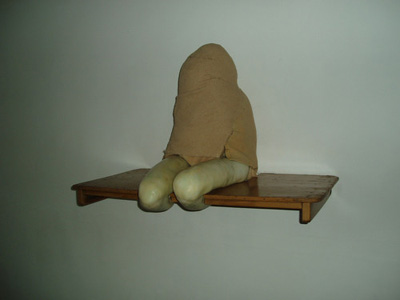 Berlinde de Bruyckere It is mainly since the last Venice Biennale, where her sculptures were shown in the Italian Pavilion, that Berlinde de Bruyckere has won international acclaim after gaining a reputation chiefly in Belgium and Holland for her numerous exhibitions and works for the public space. The Belgian artist (born in Gent, Belgium, in 1964) creates sculptures and installations that seem easily readable and understandable at first sight, but reveal deeper layers of meaning on successive viewings. In her first solo show in Switzerland at Hauser & Wirth, Berlinde de Bruyckere is presenting new sculptures and watercolours. In her sculptures and installations, Berlinde de Bruyckere combines archetypal symbols with contemporary concepts and brings to the surface layers of meanings seemingly forgotten or lost. The central themes around which her work revolves are the vulnerability of people and nature, the human need for protection and warmth, for love and understanding, but also the brutal reality dominated by aggression and violence, pain and fear. Convinced of the essential duality of being, the artist impregnates her works with inherent contradiction. In one of her early works, she sewed thousands of ribbons embroidered with the phrase "Innocence can be hell" onto 200 heavy woollen blankets that she hung up on four gigantic drying racks. The result was a sort of over-sized hut, of the kind children construct to hide and play in. The duality expressed by the sentence "Innocence can be hell" typifies the work of de Bruyckere: these reminiscences of moments of lightness and light-heartedness associated with this type of hut can easily turn into their opposites: the heavy, used blankets suddenly call to mind the fear that makes people crawl under blankets. Conjuring up media images of refugee camps, they come to stand for the vulnerability linked to situations that are to do with cold, illness, devastation and war. Thus, the used, patterned woollen blankets that the artist has used in several sculptures and installations since the early 1990s not only symbolise protection and warmth, but also vulnerability and fear - they seem to be able not only to provide shelter, but also to suffocate. Berlinde de Bruyckere's works set up a personal microcosm characterised by a few recurring symbolic elements: in addition to the numerous works that feature woollen blankets, there are installations that present trees as symbols of life, and works centred on groups of women and of horses. Rather than being strictly separate, parallel strands, the various groups of work flow into each other, blending and combining to form new compositions. One work seems to bear the seeds of the next, or it continues and deepens the ideas contained in the previous one. Thus, the "Blanket Women", as the artist calls a series of sculptures, are a continuation of the theme of the blanket: beginning in the mid-1990s, de Bruyckere has peopled works with female figures made of wax, their bodies covered with woollen blankets, thus eluding the viewer's gaze. While she was pursuing this theme, the bodies developed a cruder and more fragmentary look, with the blankets no longer loosely thrown over the figures, but practically sewn onto the bodies, like a second skin. In the same year that saw the first of the artist's horse figures - sculptures made of synthetic materials and covered with real horse skin -, the two groups of works already began to mingle: instead of covers, it was long horsehair that the artist began to use to cover the faces and bodies of her female figures - and only a little later, she would form individual parts of the horse sculptures not with horsehair, but with wax. The works shown by the artist at Hauser & Wirth are in line with earlier work and take it a step further. Having become more abstract and fragmentary, some of the most recent sculptures give the impression of extreme fragility and vulnerability, providing a view of their hollow interiors through the gaps where the body parts are joined. Unlike earlier works, however, the horse figure "Eén", 2003-2004 and the sculpture "Aanéén", 2003-2004 do not seem to be about human and animal figures hiding from the gazes of others and their isolation from the outside world, but about how to represent bodies that flow into each other to become one, as with "Eén", where fragments of two monumental horse bodies were combined to form a new whole, or about body parts that seem to grow out of each other, as with "Aanéén". And after having focused exclusively on the representation of women's bodies, de Bruyckere in her new show at Hauser & Wirth will for the first time present a sculpture after a male model. In addition to the sculptures, the show features a selection of watercolours, which represent an independent part of de Bruyckere's work and offer insights into the artist's world view and creative processes. Exhibition: August 28 - October 9, 2004 Gallery hours: Tue/Wed/Fri 12 - 6 pm, Thu 12 - 8 pm, Sat 11 am - 4 pm Galerie Hauser & Wirth Löwenbräu-Areal Limmatstrasse 270 8005 Zürich Telephone 01 446 80 50 Fax 01 446 80 55 Email info@ghw.ch www.ghw.ch |